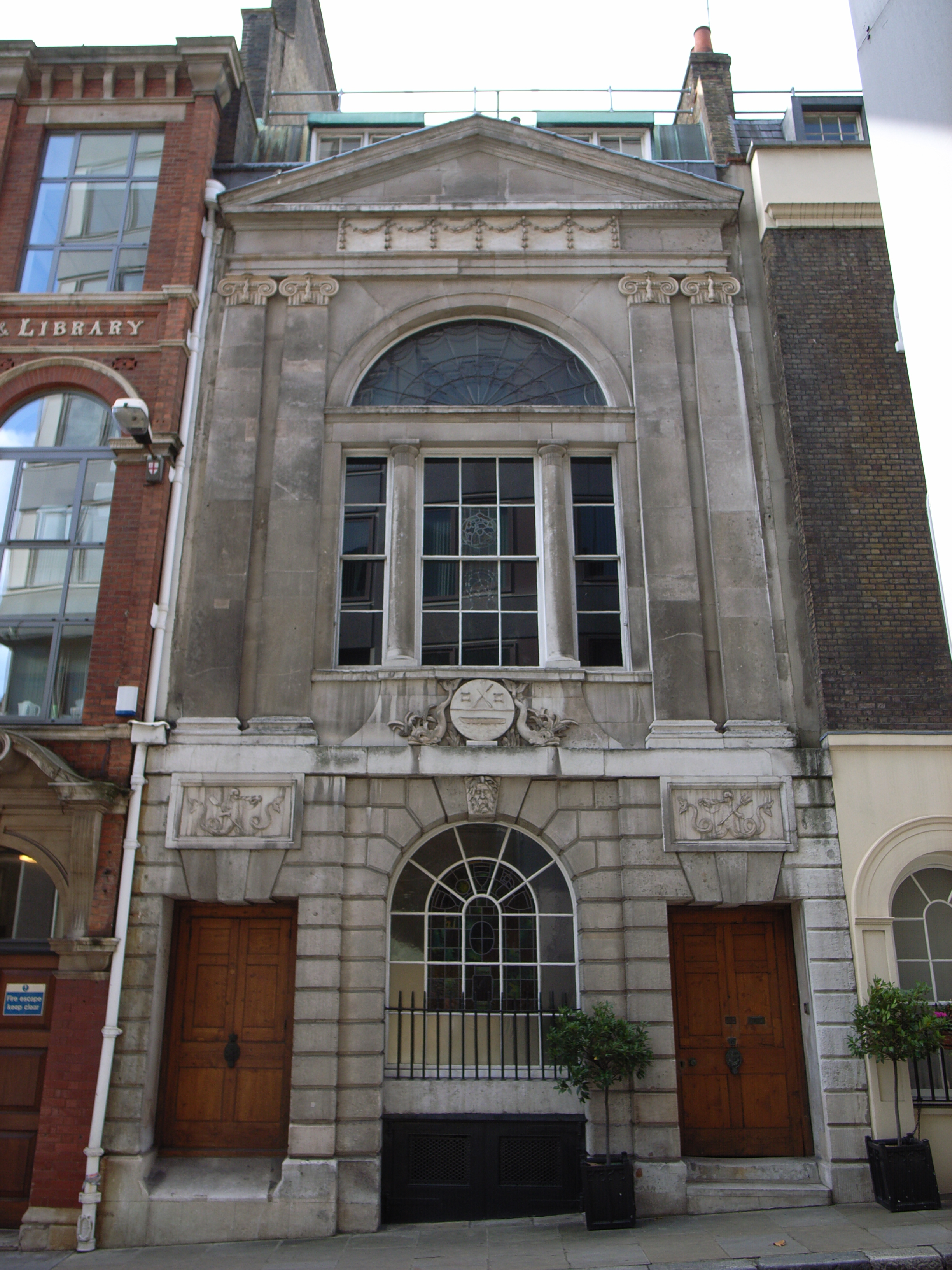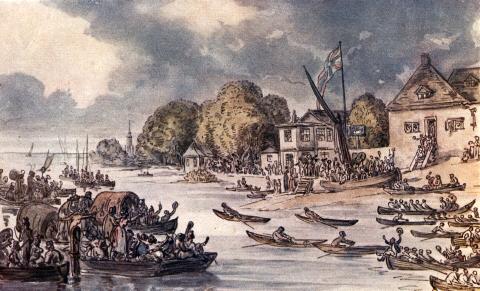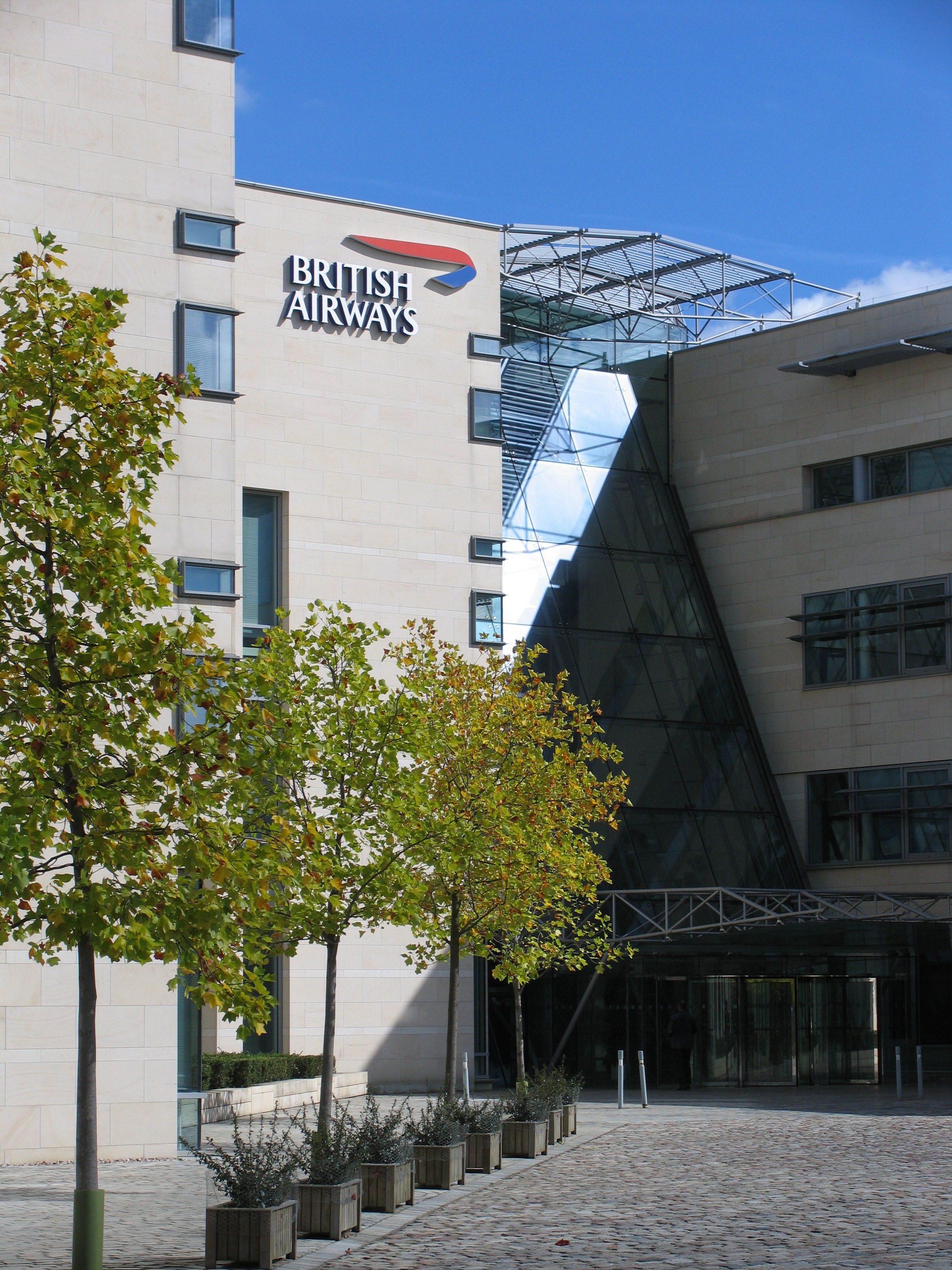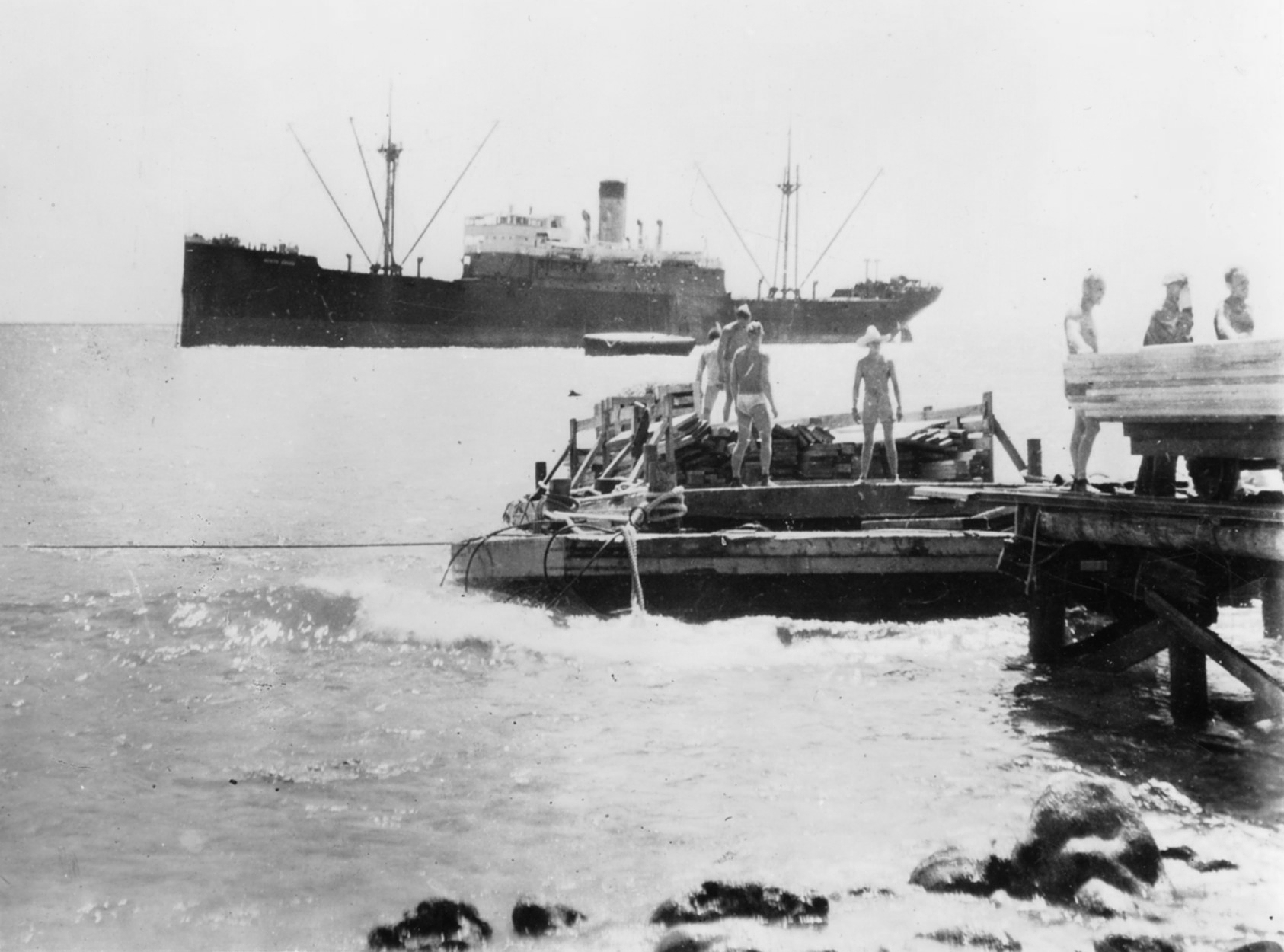|
Lightermen
A lighterman is a worker who operates a lighter, a type of flat-bottomed barge, which may be powered or unpowered. In the latter case, today it is usually moved by a powered tug. The term is particularly associated with the highly skilled men who operated the unpowered lighters moved by oar and water currents in the Port of London. Lightermen in the Port of London History Lightermen were one of the most characteristic groups of workers in London's docks during the heyday of the Port of London, but their trade was eventually rendered largely obsolete by changes in shipping technology. They were closely associated with the watermen, who carried passengers, and in 1700 joined the Company of Watermen to form the Company of Watermen and Lightermen. This is not, strictly speaking, a livery company but a "City Company Without Grant of Livery", formed in 1700 by Act of Parliament. The Guild continues to license watermen and lightermen working on the River Thames. Watermans' Hall i ... [...More Info...] [...Related Items...] OR: [Wikipedia] [Google] [Baidu] |
Company Of Watermen And Lightermen
The Company of Watermen and Lightermen (CWL) is a historic City guild in the City of London. However, unlike the city's other 109 livery companies, CWL does not have a grant of livery. Its meeting rooms are at Waterman's Hall on St Mary at Hill, London. The role of watermen was to transfer passengers, while lightermen moved goods and cargo, between the Port of London and vessels moored in the River Thames. Although modern river workers are licensed by the Maritime and Coastguard Agency, the Company continues its roles arranging apprenticeships, lobbying on river matters, and organising historic annual events and ceremonies. The company's clerk is Julie Lithgow, formerly director of the Institute of Chartered Shipbrokers. History CWL was established in the medieval period to support and maintain rights of the river workers. The two main occupations were that of watermen and lightermen. The watermen transferred passengers across and along city centre rivers and estuaries. Mo ... [...More Info...] [...Related Items...] OR: [Wikipedia] [Google] [Baidu] |
Watermen
A waterman is a river worker who transfers passengers across and along city centre rivers and estuaries in the United Kingdom and its colonies. Most notable are those on the River Thames and River Medway in England, but other rivers such as the River Tyne and River Dee, Wales, also had their watermen who formed guilds in medieval times. Waterman can also be a person who navigates a boat carrying passengers. These boats were often rowing boat or boats with sails. Over the years watermen acquired additional skills such as local pilotage, mooring vessels at berths, jetties, buoys, and docks, and acting as helmsman aboard large vessel. Watermen in the United Kingdom: 1197 to 1859 Watermen or wherrymen were an essential part of early London. Using a small boat called a wherry or skiff they would ferry passengers along and across the river. With bad rural roads and narrow congested city streets, the Thames was the most convenient highway in the region. Until the mid-18th century Londo ... [...More Info...] [...Related Items...] OR: [Wikipedia] [Google] [Baidu] |
The Thames Barge Driving Race
The Thames Barge Driving Race or Barge Race is a river-race that was set up in 1975 by a charity called The Transport On Water Association (TOW), now known as the Thames Barge Driving Trust with the backing of Members of Parliament and Members of the House of Lords in the United Kingdom. The race The race consists of about 11 teams of between four and eight members who steer and row 30 ton barges over a seven-mile course for about 90 minutes from Greenwich to Westminster Bridge. Considerable skill is needed to pilot ''unpowered'' barges 'rowed under oars' or ''sweeps'' and ride tidal river currents alone, up river. The event commemorates the skills of lightermen who moved freight this way along the Thames up until the 1930s and in a wider context it encourages ongoing interest in moving cargo via water and as a way to recruit younger people back into river trades.The teams are normally made up of employees of Thames lighterage companies, Port of London Authority or are sponsored ... [...More Info...] [...Related Items...] OR: [Wikipedia] [Google] [Baidu] |
Alight
Alight, formerly the American Refugee Committee (ARC), is an international nonprofit, nonsectarian organization that has provided humanitarian assistance and training to millions of beneficiaries over the last 40 years. In 2011, Alight helped nearly 2.5 million people get essential services to regain their health and take back control of their lives. Alight works with its partners and constituencies to provide opportunities and expertise to communities of refugees and internally displaced persons in seven countries in Africa, Asia, and Europe, including Iraq, Kosovo, and in the Darfur region of Sudan and is currently providing for emergency relief and recovery in Haiti. Alight provides shelter, clean water and sanitation, health care, skills training, microcredit education, and protection to help survivors of war and natural disasters to rebuild their lives with dignity, health care, security, and self-sufficiency. History Moved by the plight of millions of men, women and child ... [...More Info...] [...Related Items...] OR: [Wikipedia] [Google] [Baidu] |
Economy Of London
The economy of London is dominated by service industries, particularly financial services and associated professional services, which have strong links with the economy in other parts of the United Kingdom (UK) and internationally. In addition to being the capital city of the United Kingdom, London is one of the world's leading financial centres for international business and commerce and is one of the "command centres" for the global economy. London is the most populous region, urban zone and metropolitan area in the United Kingdom. London had the fifth largest metropolitan economy in the world in 2011 according to the Brookings Institution. Some of its neighbourhoods have estimated per capita GVA as high as £116,800 ($162,200). The London fiscal surplus, £32.5 billion in 2016–17, mostly goes towards funding services in other parts of the UK. London generates approximately 22 per cent of the UK's GDP. 841,000 private sector businesses were based in London at the start ... [...More Info...] [...Related Items...] OR: [Wikipedia] [Google] [Baidu] |
Marine Occupations
Marine is an adjective meaning of or pertaining to the sea or ocean. Marine or marines may refer to: Ocean * Maritime (other) * Marine art * Marine biology * Marine debris * Marine habitats * Marine life * Marine pollution Military * Marines, a naval-based infantry force ** United States Marine Corps ** Royal Marines of the UK ** Brazilian Marine Corps ** Spanish Marine Infantry ** Fusiliers marins (France) ** Indonesian Marine Corps ** Republic of China Marine Corps ** Republic of Korea Marine Corps ** Royal Thai Marine Corps *"Marine" also means "navy" in several languages: ** Austro-Hungarian Navy () ** Belgian Navy (, , ) ** Royal Canadian Navy () *** Provincial Marine (1796–1910), a predecessor to the Royal Canadian Navy ** Navy of the Democratic Republic of the Congo () ** Royal Danish Navy () ** Finnish Navy (, ) ** French Navy () ** Gabonese Navy () ** German Navy () ** Royal Moroccan Navy () ** Royal Netherlands Navy () ** Swedish Navy () Places * M ... [...More Info...] [...Related Items...] OR: [Wikipedia] [Google] [Baidu] |
Lightering
Lightering (also called lighterage) is the process of transferring cargo between vessels of different sizes, usually between a barge (lighter) and a bulker or oil tanker. Lightering is undertaken to reduce a vessel's draft so it can enter port facilities that cannot accept large fully-loaded ocean-going vessels. Lightering can also refer to the use of a lighter barge for any form of short-distance transport, such as to bring railroad cars across a river. In addition, lightering can refer to the process of removing oil or other hazardous chemicals from a compromised vessel to another vessel to prevent an oil spill. History Lightering was practiced for all types of cargo for centuries. Prior to the 19th century introduction of steamships too large to enter some of the ports they intended to serve, in which case lightering became necessary to reduce the vessels' draft sufficiently to enter the port, cargoes ranging from water to ships' stores (food, livestock, misc. supplies), to gun ... [...More Info...] [...Related Items...] OR: [Wikipedia] [Google] [Baidu] |
Containerization
Containerization is a system of intermodal freight transport using intermodal containers (also called shipping containers and ISO containers). Containerization is also referred as "Container Stuffing" or "Container Loading", which is the process of unitization of cargoes in exports. Containerization is the predominant form of unitization of export cargoes, as opposed to other systems such as the barge system or palletization. The containers have standardized dimensions. They can be loaded and unloaded, stacked, transported efficiently over long distances, and transferred from one mode of transport to another—container ships, rail transport flatcars, and semi-trailer trucks—without being opened. The handling system is completely mechanized so that all handling is done with cranes and special forklift trucks. All containers are numbered and tracked using computerized systems. Containerization originated several centuries ago but was not well developed or widely applied unti ... [...More Info...] [...Related Items...] OR: [Wikipedia] [Google] [Baidu] |
Port Of Hull
The Port of Hull is a port at the confluence of the River Hull and the Humber Estuary in Kingston upon Hull, in the East Riding of Yorkshire, England. Seaborne trade at the port can be traced to at least the 13th century, originally conducted mainly at the outfall of the River Hull, known as The Haven, or later as the Old Harbour. In 1773, the Hull Dock Company was formed and Hull's first dock built on land formerly occupied by Hull town walls. In the next half century a ring of docks was built around the Old Town on the site of the former fortifications, known as the Town Docks. The first was The Dock (1778), (or The Old Dock, known as Queen's Dock after 1855), followed by Humber Dock (1809) and Junction Dock (1829). An extension, Railway Dock (1846), was opened to serve the newly built Hull and Selby Railway. The first dock east of the river, Victoria Dock, opened in 1850. Docks along the banks of the Humber to the west were begun in 1862 with the construction of the We ... [...More Info...] [...Related Items...] OR: [Wikipedia] [Google] [Baidu] |
Humber Estuary
The Humber is a large tidal estuary on the east coast of Northern England. It is formed at Trent Falls, Faxfleet, by the confluence of the tidal rivers Ouse and Trent. From there to the North Sea, it forms part of the boundary between the East Riding of Yorkshire on the north bank and North Lincolnshire on the south bank. Although the Humber is an estuary from the point at which it is formed, many maps show it as the River Humber. Below Trent Falls, the Humber passes the junction with the Market Weighton Canal on the north shore, the confluence of the River Ancholme on the south shore; between North Ferriby and South Ferriby and under the Humber Bridge; between Barton-upon-Humber on the south bank and Kingston upon Hull on the north bank (where the River Hull joins), then meets the North Sea between Cleethorpes on the Lincolnshire side and the long and thin headland of Spurn Head to the north. Ports on the Humber include the Port of Hull, the Port of Grimsby and the Port ... [...More Info...] [...Related Items...] OR: [Wikipedia] [Google] [Baidu] |








